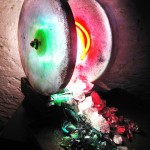March 6th 2015 – April 10th 2015

Federica Marangoni | Glass Memory
by Viana Conti
Opening, friday march 6th 2015 at 18.00
Glass Memory by Viana Conti
C/E Contemporary, Milan, launches its 2015 season with a solo exhibition, Memory of Glass, of work by the renowned international artist Federica Marangoni. Curated by Viana Conti, the opening will be on Friday 6 March, from 6 pm till 10 pm, in the presence of the artist and with an introduction by the curator at 7 pm.
With this exhibition the Venetian artist combines her present with a revisitation of the past to create an impressi- ve array of works in glass, video and neon. Radiating her Weltanschauung, her own peculiar Vision of the World runs like a movie through the filter of memory, in a narrative thread and aesthetic statement of extra, inter and intra-personal communication.
Undoubtedly a video pioneer, in the early 1970s Marangoni was already experimenting with innovative technological materials like fibre-glass, polyester, Perspex, neon and glass that would distinguish the whole of her artistic output. In 1980 her historic, installation-performance The Interrogation was presented, together with the world premiere of her film The Box of Life, at the MoMA in New York. As a contemporary artist, she may be placed alongside such conceptual peers as Nam June Paik, Dan Flavin, Bruce Naumann, Joseph Kosuth, Jenny Holzer and Barbara Kruger. In 2001 the Peggy Guggenheim Collection in Venice staged a Special Event to celebrate her thirtieth year of artistic activity. The event was introduced by the book, published by Fidia-Museo del Parco di Portofino, Federica Marangoni – electronic: mother of a humanistic dream, by the late famed art historian and critic Pierre Restany, who had constantly followed and appreciated her artistic evolution and innovation. Shown on that historic evening was her video-installation, comprising six monitors, titled Bleeding Heart/Dripping Rainbow. In its reference to the real disaster of the 9/11attack on the Twin Towers, its visual language represented a heart that never ceases to bleed, next to a rainbow that ceaselessly dissolves into its most iridescent colours. Reflected on a glass sphere, the media universe of mass fetishes and stereotypes is broken down in her work, into myriad fragments that rewrite, through light and shade, the conflictual story of humanity. This exhibition stages an intense journey between East and West, interwoven with the golden threads of Byzantine culture, the red blood of genocide and crimes against humanity. It speaks of tolerance and intolerance, flights from reality and landings on the crystalline beaches of the imaginary, enlightened by knowledge, beauty and poetry. A vertical sequence of rungs in red neon tube, altered modified to create a continuously interrupted gas emission and the visual effect of an electrical discharge, draws the eye up to a horizon so wide that the ladder itself becomes useless. Words, too, are rendered Wittgensteinishly superfluous and unutterable in a reality unfolded. In the panorama of stored information issuing into a communicational desert, an installation of cracked glass monitors breaks contact and reduces it to splinters, inviting silence. Written in neon, with symbolic colours scat- tered across the walls, they express appeals to peace, freedom, solidarity and a voice for minorities. Next to a bleeding heart stands a brand new video-sculpture. Composed of two synchronized screens, it is dedicated by the artist to the comparison of past and present and, installed on the end wall, reminds us that Life is time and memory of time. Meanwhile, with clothes and cloaks in a renaissance mood, it recreates scenographic and iconographic sets, borrowed from Cimabue and Piero della Francesca, of an archaic world revisited by the artist. Sacrality, beauty and harmony are here compared with the Chaos of Humanity, a Babel of languages, swarming subjects of malaise and fear, that duplicate and multiply until the globe explodes like a china vase. Spelt out by the rhythm of a heartbeat, photograms of an exploited and hungry childhood, antifeminist violence and religious fanaticism carried to inconceivable extremes, move across the spectator’s vision in the terms of a war reportage. A Murano glass hand, drenched with red, stretches out to protect the word Tolerance. A monitor enclosed in a metal micro-cage presents the video titled Self-portrait-I wanted to tell you that…, in which the artist herself, deprived of sound, speaks through the world’s deafening chaos to interlocutors who do not listen. Attentive to Marshall McLuhan’s Canadian school of thought, Marangoni’s work quickly identified the medium with the message. In her projects from the 1970s, the glacial quality of glass is animated with emotion and pathos. Inevitably and epochally a citizen of the Global Village, Federica Marangoni recaptures, in a climate of linguistic homologation, her own peculiar Sign that lends inimitable Form to her Thinking and Poetic outlook.






































